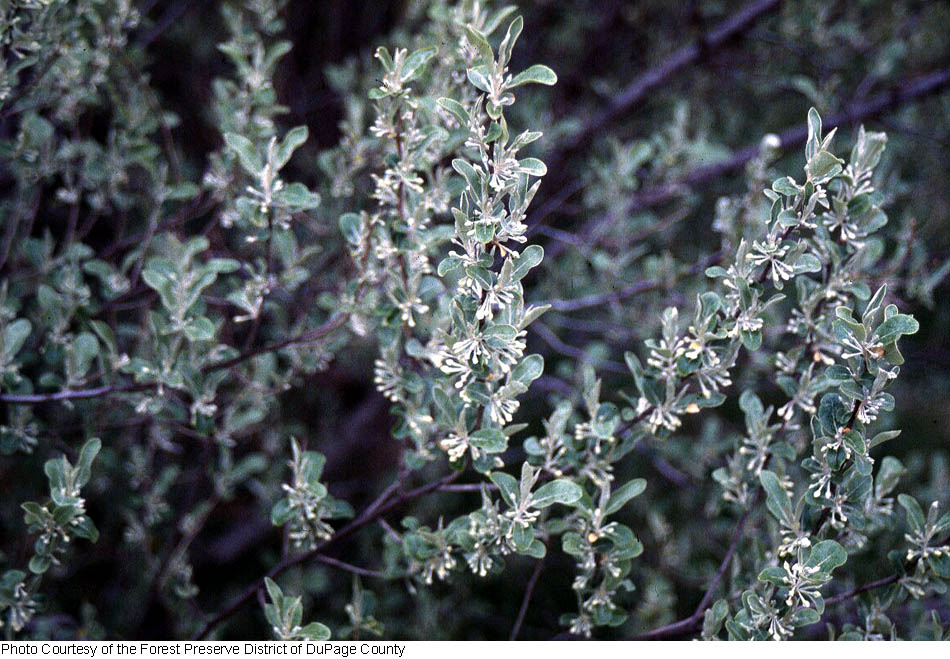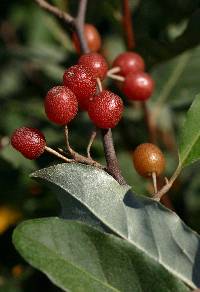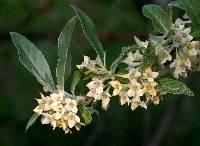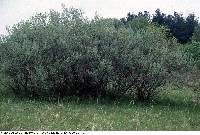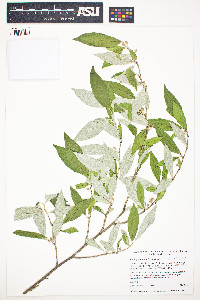|
|
|
|
Family: Elaeagnaceae
autumn olive
|
Shrub to 5.5 m tall, as wide as tall Leaves: alternate, bright green, 5 - 10 cm long, 2 - 4 cm wide, elliptic to oblong or egg-shaped with a rounded to slightly tapered base, sometimes with few scales above, covered with silver scales and few brown scales beneath. Flowers: solitary or in groups of two or three near leaf axils, sliver-white, tubular calyx with tube longer than calyx lobes. Fruit: fleshy with an achene in the center, borne on a stalk to 1 cm long, red with dots of pale scales, 6 - 8 mm long, abundant, fragrant. Twigs: covered with silver and brown scales, often spiny. Similar species: All species of the Elaeagnaceae family in the Chicago Region have silvery white leaves with non-toothed margins, flowers with a tubular calyx and no petals, and berry-like fruit. Shepherdia canadensis is a 1 - 3 m tall shrub with opposite leaves, while species of Elaeagnus have alternate leaves. Elaeagnus angustifolia is a shrub or tree reaching 10 m tall, has twigs with or without thorns, lance-shaped leaves silver on both surfaces, a yellow calyx center, and yellow fruit with silver scales. Elaeagnus multiflora is a 2 m tall shrub that has elliptic to egg-shaped leaves with green upper and silver lower surfaces, equal length calyx tube and lobes, and red fruit on a 1.5 - 2.5 cm stalk. Flowering: May to early June Habitat and ecology: Commonly escapes from cultivation into degraded open woods, railroad right-of-ways, unmowed meadows, and old fields. Elaeagnus umbellata adapts to many soil conditions, is drought tolerant, and has a symbiotic relationship with a nitrogen-fixing bacteria. Occurence in the Chicago region: non-native Notes: Elaeagnus umbellata was introduced from Asia for wildlife forage and soil reclamation, because it produces abundant fruit and tolerates a wide range of growing conditions. Unfortunately, this species has become invasive in many parts of the United States as birds spread the seeds into natural areas. Etymology: Elaeagnus comes from the Greek words elaia, meaning olive, and agnos, meaning pure, referring to the resemblance of the fruit and foliage to a true olive, Olea sp. Umbellata means "in umbels." Author: The Morton Arboretum Shrubby tree to 5 m; lvs soon green and glabrescent above; hypanthium-tube ca twice as long as the sep; fr red, finely dotted with pale scales, juicy and edible, 6-8 mm, on pedicels ca 1 cm; 2n=28. Native of e. Asia, becoming common in much of our range. May, June. Gleason, Henry A. & Cronquist, Arthur J. 1991. Manual of vascular plants of northeastern United States and adjacent Canada. lxxv + 910 pp. ©The New York Botanical Garden. All rights reserved. Used by permission. |


